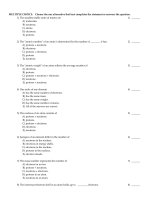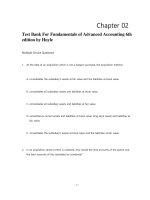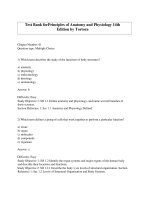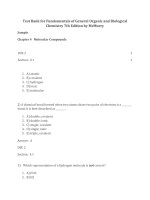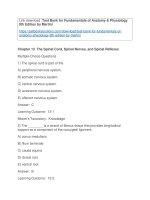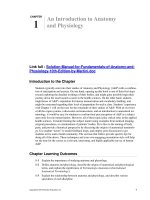Test bank for fundamentals of anatomy and physiology 11e c12
Bạn đang xem bản rút gọn của tài liệu. Xem và tải ngay bản đầy đủ của tài liệu tại đây (358.94 KB, 37 trang )
Chapterȱ12 NervousȱTissue
Multiple Choice Questions
1) Theȱ________ȱnervousȱsystemȱisȱcomposedȱofȱtheȱbrainȱandȱspinalȱcord.
A) autonomic
B) peripheral
C) central
D) efferent
E) afferent
Answer: C
LearningȱOutcome: 12-1
BloomȇsȱTaxonomy: Remembering
2) Theȱ________ȱnervousȱsystemȱcontrolsȱtheȱskeletalȱmuscles.
A) sympathetic
B) parasympathetic
C) afferent
D) somatic
E) autonomic
Answer: D
LearningȱOutcome: 12-1
BloomȇsȱTaxonomy: Remembering
3) TheȱpartȱofȱtheȱperipheralȱnervousȱsystemȱthatȱcarriesȱsensoryȱinformationȱtoȱtheȱCNSȱis
designated
A) motor.
B) afferent.
C) efferent.
D) autonomic.
E) somatic.
Answer: B
LearningȱOutcome: 12-1
BloomȇsȱTaxonomy: Remembering
4) Theȱefferentȱdivisionȱofȱtheȱperipheralȱnervousȱsystemȱinnervatesȱ________ȱcells.
A) skeletalȱmuscle
B) smoothȱmuscle
C) heartȱmuscle
D) glandular
E) Allȱofȱtheȱanswersȱareȱcorrect.
Answer: E
LearningȱOutcome: 12-1
BloomȇsȱTaxonomy: Remembering
Copyrightȱ©ȱ2018ȱPearsonȱEducation,ȱInc.
Chapterȱ12ȱȱNervousȱTissueȱȱȱ365
5) Theȱnervousȱtissueȱoutsideȱofȱtheȱcentralȱnervousȱsystemȱcomposesȱtheȱ________ȱnervous
system.
A) somatic
B) peripheral
C) autonomic
D) afferent
E) parasympathetic
Answer: B
LearningȱOutcome: 12-1
BloomȇsȱTaxonomy: Remembering
6) Theȱ________ȱdivisionȱofȱtheȱperipheralȱnervousȱsystemȱbringsȱsensoryȱinformationȱtoȱthe
centralȱnervousȱsystem.
A) somatic
B) peripheral
C) autonomic
D) afferent
E) parasympathetic
Answer: D
LearningȱOutcome: 12-1
BloomȇsȱTaxonomy: Remembering
7) Theȱ________ȱdivisionȱofȱtheȱnervousȱsystemȱcarriesȱmotorȱcommandsȱtoȱmusclesȱandȱglands.
A) spinal
B) peripheral
C) autonomic
D) afferent
E) efferent
Answer: E
LearningȱOutcome: 12-1
BloomȇsȱTaxonomy: Remembering
8) Theȱ________ȱnervousȱsystemȱprovidesȱinvoluntaryȱregulationȱofȱsmoothȱmuscle,ȱcardiac
muscle,ȱandȱglandularȱactivity.
A) somatic
B) peripheral
C) autonomic
D) afferent
E) motor
Answer: C
LearningȱOutcome: 12-1
BloomȇsȱTaxonomy: Remembering
Copyrightȱ©ȱ2018ȱPearsonȱEducation,ȱInc.
366ȱȱȱTestȱBankȱforȱFundamentalsȱofȱAnatomyȱ&ȱPhysiology,ȱ11e
9) ________ȱcarryȱmotorȱinformationȱtoȱperipheralȱeffectors.
A) Unipolarȱneurons
B) Efferentȱneurons
C) Multipolarȱneurons
D) Afferentȱneurons
E) Interneurons
Answer: B
LearningȱOutcome: 12-1
BloomȇsȱTaxonomy: Remembering
10) ________ȱnervesȱareȱnervesȱthatȱconnectȱtoȱtheȱspinalȱcord.
A) Spinal
B) Cranial
C) Afferent
D) Multipolar
E) Autonomic
Answer: A
LearningȱOutcome: 12-1
BloomȇsȱTaxonomy: Remembering
11) ________ȱnervesȱareȱnervesȱthatȱconnectȱtoȱtheȱbrain.
A) Spinal
B) Unmyelinated
C) Myelinated
D) Cranial
E) Interneural
Answer: D
LearningȱOutcome: 12-1
BloomȇsȱTaxonomy: Remembering
12) Theȱaxoplasmȱofȱtheȱaxonȱcontainsȱwhichȱofȱtheȱfollowing?
A) neurotubules
B) mitochondria
C) vesicles
D) neurofibrils
E) Allȱofȱtheȱanswersȱareȱcorrect.
Answer: E
LearningȱOutcome: 12-2
BloomȇsȱTaxonomy: Remembering
13) Whichȱofȱtheȱfollowingȱisȱnotȱaȱrecognizedȱstructuralȱclassificationȱforȱneurons?
A) anaxonic
B) bipolar
C) multipolar
D) pseudopolar
E) unipolar
Answer: D
LearningȱOutcome: 12-2
BloomȇsȱTaxonomy: Remembering
Copyrightȱ©ȱ2018ȱPearsonȱEducation,ȱInc.
Chapterȱ12ȱȱNervousȱTissueȱȱȱ367
14) Theȱmostȱabundantȱclassȱofȱneuronȱinȱtheȱcentralȱnervousȱsystemȱis
A) anaxonic.
B) bipolar.
C) multipolar.
D) pseudopolar.
E) unipolar.
Answer: C
LearningȱOutcome: 12-2
BloomȇsȱTaxonomy: Remembering
15) Theȱcytoplasmȱthatȱsurroundsȱtheȱnucleusȱofȱaȱneuronȱisȱcalledȱthe
A) protoplasm.
B) nucleoplasm.
C) sarcoplasm.
D) neuroplasm.
E) perikaryon.
Answer: E
LearningȱOutcome: 12-2
BloomȇsȱTaxonomy: Remembering
16) ClustersȱofȱRERȱandȱfreeȱribosomesȱinȱneuronsȱareȱcalled
A) neurofilaments.
B) neurofibrils.
C) perikaryon.
D) Nisslȱbodies.
E) microglia.
Answer: D
LearningȱOutcome: 12-2
BloomȇsȱTaxonomy: Remembering
17) Theȱaxonȱisȱconnectedȱtoȱtheȱsomaȱatȱthe
A) telodendria.
B) synapticȱterminal.
C) collaterals.
D) axonȱhillock.
E) synapse.
Answer: D
LearningȱOutcome: 12-2
BloomȇsȱTaxonomy: Remembering
18) Branchesȱthatȱmayȱoccurȱalongȱanȱaxonȱareȱcalled
A) telodendria.
B) synapticȱterminals.
C) collaterals.
D) hillocks.
E) synapses.
Answer: C
LearningȱOutcome: 12-2
BloomȇsȱTaxonomy: Remembering
Copyrightȱ©ȱ2018ȱPearsonȱEducation,ȱInc.
368ȱȱȱTestȱBankȱforȱFundamentalsȱofȱAnatomyȱ&ȱPhysiology,ȱ11e
19) Axonsȱterminateȱinȱaȱseriesȱofȱfineȱextensionsȱknownȱas
A) telodendria.
B) terminals.
C) collaterals.
D) dendrites.
E) synapses.
Answer: A
LearningȱOutcome: 12-2
BloomȇsȱTaxonomy: Remembering
20) Theȱsiteȱofȱintercellularȱcommunicationȱbetweenȱaȱneuronȱandȱanotherȱcellȱisȱthe
A) telodendria.
B) axolemma.
C) collateral.
D) hillock.
E) synapse.
Answer: E
LearningȱOutcome: 12-2
BloomȇsȱTaxonomy: Remembering
21) TheȱrabiesȱvirusȱtravelsȱtoȱtheȱCNSȱvia
A) anterogradeȱaxoplasmicȱtransport.
B) retrogradeȱaxoplasmicȱtransport.
C) bloodȱvessels.
D) subcutaneousȱconnectiveȱtissue.
E) cerebrospinalȱfluid.
Answer: B
LearningȱOutcome: 12-2
BloomȇsȱTaxonomy: Understanding
22) Neuronsȱthatȱareȱrare,ȱsmall,ȱandȱlackȱfeaturesȱthatȱdistinguishȱdendritesȱfromȱaxonsȱareȱcalled
A) anaxonic.
B) unipolar.
C) bipolar.
D) tripolar.
E) multipolar.
Answer: A
LearningȱOutcome: 12-2
BloomȇsȱTaxonomy: Remembering
23) Neuronsȱinȱwhichȱdendriticȱandȱaxonalȱprocessesȱareȱcontinuousȱandȱtheȱsomaȱliesȱoffȱtoȱone
sideȱareȱcalled
A) anaxonic.
B) unipolar.
C) bipolar.
D) tripolar.
E) multipolar.
Answer: B
LearningȱOutcome: 12-2
BloomȇsȱTaxonomy: Remembering
Copyrightȱ©ȱ2018ȱPearsonȱEducation,ȱInc.
Chapterȱ12ȱȱNervousȱTissueȱȱȱ369
24) Neuronsȱthatȱhaveȱoneȱaxonȱandȱoneȱdendrite,ȱwithȱtheȱsomaȱinȱbetween,ȱareȱcalled
A) anaxonic.
B) unipolar.
C) bipolar.
D) tripolar.
E) multipolar.
Answer: C
LearningȱOutcome: 12-2
BloomȇsȱTaxonomy: Remembering
25) Neuronsȱthatȱhaveȱseveralȱdendritesȱandȱaȱsingleȱaxonȱareȱcalled
A) anaxonic.
B) unipolar.
C) bipolar.
D) tripolar.
E) multipolar.
Answer: E
LearningȱOutcome: 12-2
BloomȇsȱTaxonomy: Remembering
26) SensoryȱneuronsȱofȱtheȱPNSȱare
A) unipolar.
B) bipolar.
C) anaxonic.
D) multipolar.
E) tripolar.
Answer: A
LearningȱOutcome: 12-2
BloomȇsȱTaxonomy: Remembering
27) Whichȱofȱtheȱfollowingȱactivitiesȱorȱsensationsȱis/areȱnotȱmonitoredȱbyȱinteroceptors?
A) sight
B) pain
C) activitiesȱofȱtheȱdigestiveȱsystem
D) cardiovascularȱactivities
E) urinaryȱactivities
Answer: A
LearningȱOutcome: 12-2
BloomȇsȱTaxonomy: Understanding
28) ________ȱareȱtheȱmostȱnumerousȱtypeȱofȱneuronȱinȱtheȱCNS.
A) Sensoryȱneurons
B) Motorȱneurons
C) Unipolarȱneurons
D) Bipolarȱneurons
E) Interneurons
Answer: E
LearningȱOutcome: 12-2
BloomȇsȱTaxonomy: Remembering
Copyrightȱ©ȱ2018ȱPearsonȱEducation,ȱInc.
370ȱȱȱTestȱBankȱforȱFundamentalsȱofȱAnatomyȱ&ȱPhysiology,ȱ11e
29) Howȱdoesȱblockingȱretrogradeȱaxoplasmicȱtransportȱinȱanȱaxonȱaffectȱtheȱactivityȱofȱaȱneuron?
A) Theȱneuronȱbecomesȱunableȱtoȱproduceȱneurotransmitters.
B) Theȱneuronȱbecomesȱunableȱtoȱproduceȱactionȱpotentials.
C) Theȱsomaȱbecomesȱunableȱtoȱexportȱproductsȱtoȱtheȱsynapticȱterminals.
D) Theȱsomaȱbecomesȱunableȱtoȱrespondȱtoȱchangesȱinȱtheȱdistalȱendȱofȱtheȱaxon.
E) Theȱneuronȱbecomesȱunableȱtoȱdepolarizeȱwhenȱstimulated.
Answer: D
LearningȱOutcome: 12-2
BloomȇsȱTaxonomy: Understanding
Figureȱȱ12-1ȱTheȱNeuron
UseȱFigureȱ12-1ȱtoȱanswerȱtheȱfollowingȱquestions:
30) TheȱstructuresȱlabeledȱȈ1Ȉȱareȱdendrites.ȱTheirȱmembranesȱcontainȱnumerousȱchemically -gated
ionȱchannels.
A) Theȱfirstȱstatementȱisȱtrueȱbutȱtheȱsecondȱstatementȱisȱfalse.
B) Theȱfirstȱstatementȱisȱfalseȱbutȱtheȱsecondȱstatementȱisȱtrue.
C) Bothȱstatementsȱareȱtrue.
D) Bothȱstatementsȱareȱfalse.
Answer: C
LearningȱOutcome: 12-2
BloomȇsȱTaxonomy: Applying
31) TheȱstructureȱlabeledȱȈ2Ȉȱisȱa(n)
A) neurofilament.
B) dendrite.
C) initialȱsegment.
D) perikaryon.
E) axon.
Answer: A
LearningȱOutcome: 12-2
BloomȇsȱTaxonomy: Applying
Copyrightȱ©ȱ2018ȱPearsonȱEducation,ȱInc.
Chapterȱ12ȱȱNervousȱTissueȱȱȱ371
32) WhichȱtypeȱofȱmembraneȱchannelsȱareȱfoundȱatȱlabelȱȈ3Ȉ?
A) voltage-gatedȱNa+ ȱchannels
B) voltage-gatedȱK+ ȱchannels
C) chemically-gatedȱNa+ ȱandȱK+ ȱchannels
D) voltage-gatedȱCa2+ ȱchannels
E) bothȱvoltage-gatedȱNa+ ȱchannelsȱandȱvoltage-gatedȱK+ ȱchannels
Answer: E
LearningȱOutcome: 12-2
BloomȇsȱTaxonomy: Applying
33) IdentifyȱtheȱstructureȱlabeledȱȈ4.Ȉ
A) synapticȱterminals
B) telodendria
C) dendriticȱspines
D) collateralȱbranches
E) axons
Answer: B
LearningȱOutcome: 12-2
BloomȇsȱTaxonomy: Applying
34) IdentifyȱtheȱstructureȱlabeledȱȈ5.Ȉ
A) axons
B) telodendria
C) dendriticȱspines
D) synapticȱterminals
E) collateralȱbranch
Answer: D
LearningȱOutcome: 12-2
BloomȇsȱTaxonomy: Applying
35) WhatȱisȱcontainedȱinsideȱtheȱstructureȱlabeledȱȈ5Ȉ?
A) neuroglia
B) sodiumȱions
C) acetylcholinesterase
D) calciumȱions
E) neurotransmitterȱmolecules
Answer: E
LearningȱOutcome: 12-2
BloomȇsȱTaxonomy: Applying
36) Whichȱpart(s)ȱofȱtheȱneuronȱcanȱpropagateȱanȱactionȱpotential?
A) 1
B) 1ȱandȱ2
C) 2ȱandȱ3
D) 3
Answer: D
LearningȱOutcome: 12-2
BloomȇsȱTaxonomy: Applying
Copyrightȱ©ȱ2018ȱPearsonȱEducation,ȱInc.
372ȱȱȱTestȱBankȱforȱFundamentalsȱofȱAnatomyȱ&ȱPhysiology,ȱ11e
37) Onȱwhichȱstructureȱdoȱmostȱneuronȱtoȱneuronȱcommunicationsȱoccur?
A) 2
B) 1
C) 3
D) 4
E) 5
Answer: B
LearningȱOutcome: 12-2
BloomȇsȱTaxonomy: Applying
38) ________ȱmonitorȱtheȱpositionȱofȱskeletalȱmusclesȱandȱjoints.
A) Proprioceptors
B) Internoceptors
C) Photoreceptors
D) Exteroceptors
E) Pressoreceptors
Answer: A
LearningȱOutcome: 12-2
BloomȇsȱTaxonomy: Remembering
39) ________ȱcarryȱsensoryȱinformationȱtoȱtheȱCNS.
A) Motorȱneurons
B) Efferentȱneurons
C) Multipolarȱneurons
D) Afferentȱneurons
E) Interneurons
Answer: D
LearningȱOutcome: 12-2
BloomȇsȱTaxonomy: Remembering
40) ________ȱprovideȱinformationȱaboutȱtheȱexternalȱenvironment.
A) Spinalȱnerves
B) Anaxonicȱneurons
C) Internoceptors
D) Exteroceptors
E) Proprioceptors
Answer: D
LearningȱOutcome: 12-2
BloomȇsȱTaxonomy: Remembering
41) ________ȱmonitorȱtheȱdigestive,ȱrespiratory,ȱcardiovascular,ȱurinary,ȱandȱreproductive
systems.
A) Spinalȱnerves
B) Unipolarȱneurons
C) Internoceptors
D) Exteroceptors
E) Proprioceptors
Answer: C
LearningȱOutcome: 12-2
BloomȇsȱTaxonomy: Remembering
Copyrightȱ©ȱ2018ȱPearsonȱEducation,ȱInc.
Chapterȱ12ȱȱNervousȱTissueȱȱȱ373
42) Theȱplasmaȱmembraneȱofȱanȱaxonȱisȱcalledȱthe
A) axonȱterminal.
B) neurilemma.
C) myelinȱsheath.
D) sarcolemma.
E) axolemma.
Answer: E
LearningȱOutcome: 12-2
BloomȇsȱTaxonomy: Remembering
43) Theȱbasicȱfunctionalȱunitȱofȱtheȱnervousȱsystemȱisȱthe
A) neuron.
B) axon.
C) nerve.
D) glialȱcell.
E) receptor.
Answer: A
LearningȱOutcome: 12-2
BloomȇsȱTaxonomy: Remembering
44) Theȱmostȱcommonȱneuronȱofȱtheȱnervousȱsystemȱisȱthe
A) interneuron.
B) externoceptor.
C) bipolarȱneuron.
D) unipolarȱneuron.
E) microglialȱcell.
Answer: A
LearningȱOutcome: 12-2
BloomȇsȱTaxonomy: Remembering
45) Mostȱneuronsȱlackȱ________ȱandȱsoȱareȱpermanentlyȱblockedȱfromȱundergoingȱcellȱdivision.
A) ribosomes
B) endoplasmicȱreticula
C) aȱnucleus
D) centrioles
E) cytoplasm
Answer: D
LearningȱOutcome: 12-2
BloomȇsȱTaxonomy: Remembering
46) Deterioratingȱchangesȱinȱtheȱdistalȱsegmentȱofȱanȱaxonȱasȱaȱresultȱofȱaȱbreakȱbetweenȱitȱandȱthe
somaȱisȱcalledȱ________ȱdegeneration.
A) neural
B) central
C) peripheral
D) Wallerian
E) conduction
Answer: D
LearningȱOutcome: 12-3
BloomȇsȱTaxonomy: Remembering
Copyrightȱ©ȱ2018ȱPearsonȱEducation,ȱInc.
374ȱȱȱTestȱBankȱforȱFundamentalsȱofȱAnatomyȱ&ȱPhysiology,ȱ11e
47) Whichȱofȱtheȱfollowingȱisȱnotȱaȱfunctionȱofȱtheȱneuroglia?
A) support
B) memory
C) secretionȱofȱcerebrospinalȱfluid
D) maintenanceȱofȱblood-brainȱbarrier
E) phagocytosis
Answer: B
LearningȱOutcome: 12-3
BloomȇsȱTaxonomy: Understanding
48) Whichȱofȱtheȱfollowingȱisȱaȱtypeȱofȱglialȱcellȱfoundȱinȱtheȱperipheralȱnervousȱsystem?
A) astrocytes
B) satelliteȱcells
C) oligodendrocytes
D) microglia
E) ependymalȱcells
Answer: B
LearningȱOutcome: 12-3
BloomȇsȱTaxonomy: Remembering
49) Theȱlargestȱandȱmostȱnumerousȱofȱtheȱglialȱcellsȱinȱtheȱcentralȱnervousȱsystemȱareȱthe
A) astrocytes.
B) satelliteȱcells.
C) oligodendrocytes.
D) microglia.
E) ependymalȱcells.
Answer: A
LearningȱOutcome: 12-3
BloomȇsȱTaxonomy: Remembering
50) Functionsȱofȱastrocytesȱincludeȱallȱofȱtheȱfollowing except
A) maintainingȱtheȱblood-brainȱbarrier.
B) conductingȱactionȱpotentials.
C) guidingȱneuronȱdevelopment.
D) respondingȱtoȱneuralȱtissueȱdamage.
E) formingȱaȱthree-dimensionalȱframeworkȱforȱtheȱCNS.
Answer: B
LearningȱOutcome: 12-3
BloomȇsȱTaxonomy: Understanding
51) ________ȱaccountȱforȱroughlyȱhalfȱofȱtheȱvolumeȱofȱtheȱnervousȱsystem.
A) Axons
B) Dendrites
C) Neuroglia
D) Synapses
E) Efferentȱfibers
Answer: C
LearningȱOutcome: 12-3
BloomȇsȱTaxonomy: Remembering
Copyrightȱ©ȱ2018ȱPearsonȱEducation,ȱInc.
Chapterȱ12ȱȱNervousȱTissueȱȱȱ375
52) Theȱneuroglialȱcellsȱthatȱparticipateȱinȱmaintainingȱtheȱblood -brainȱbarrierȱareȱthe
A) astrocytes.
B) ependymalȱcells.
C) microglia.
D) oligodendrocytes.
E) Schwannȱcells.
Answer: A
LearningȱOutcome: 12-3
BloomȇsȱTaxonomy: Remembering
53) TheȱmyelinȱsheathȱthatȱcoversȱmanyȱCNSȱaxonsȱisȱformedȱby
A) astrocytes.
B) satelliteȱcells.
C) oligodendrocytes.
D) microglia.
E) ependymalȱcells.
Answer: C
LearningȱOutcome: 12-3
BloomȇsȱTaxonomy: Remembering
54) ________ȱlineȱtheȱbrainȱventriclesȱandȱspinalȱcanal.
A) Astrocytes
B) Satelliteȱcells
C) Oligodendrocytes
D) Microglia
E) Ependymalȱcells
Answer: E
LearningȱOutcome: 12-3
BloomȇsȱTaxonomy: Remembering
55) Small,ȱwanderingȱcellsȱthatȱengulfȱcellȱdebrisȱandȱpathogensȱinȱtheȱCNSȱareȱcalled
A) astrocytes.
B) satelliteȱcells.
C) oligodendrocytes.
D) microglia.
E) ependymalȱcells.
Answer: D
LearningȱOutcome: 12-3
BloomȇsȱTaxonomy: Remembering
56) Theȱneurilemmaȱofȱaxonsȱinȱtheȱperipheralȱnervousȱsystemȱisȱformedȱby
A) astrocytes.
B) satelliteȱcells.
C) oligodendrocytes.
D) microglia.
E) Schwannȱcells.
Answer: E
LearningȱOutcome: 12-3
BloomȇsȱTaxonomy: Remembering
Copyrightȱ©ȱ2018ȱPearsonȱEducation,ȱInc.
376ȱȱȱTestȱBankȱforȱFundamentalsȱofȱAnatomyȱ&ȱPhysiology,ȱ11e
57) Glialȱcellsȱthatȱsurroundȱtheȱneuronsȱinȱgangliaȱare
A) astrocytes.
B) satelliteȱcells.
C) oligodendrocytes.
D) microglia.
E) ependymalȱcells.
Answer: B
LearningȱOutcome: 12-3
BloomȇsȱTaxonomy: Remembering
58) Damageȱtoȱependymalȱcellsȱwouldȱmostȱlikelyȱaffectȱthe
A) formationȱofȱmyelinȱsheaths.
B) formationȱofȱcerebrospinalȱfluid.
C) formationȱofȱganglia.
D) repairȱofȱaxons.
E) transportȱofȱneurotransmittersȱwithinȱaxons.
Answer: B
LearningȱOutcome: 12-3
BloomȇsȱTaxonomy: Understanding
59) Whenȱpressureȱisȱappliedȱtoȱneuralȱtissue,ȱallȱofȱtheȱfollowingȱeffectsȱareȱpossibleȱ except
A) aȱdecreaseȱinȱbloodȱflow.
B) aȱdecreaseȱinȱavailableȱoxygen.
C) aȱchangeȱinȱneuronȱexcitability.
D) glialȱcellsȱdegenerate.
E) neuronsȱareȱtriggeredȱtoȱdivide.
Answer: E
LearningȱOutcome: 12-3
BloomȇsȱTaxonomy: Understanding
60) Inȱtheȱperipheralȱnervousȱsystem,ȱSchwannȱcellsȱparticipateȱinȱtheȱrepairȱofȱdamagedȱnerves
by
A) producingȱnewȱaxons.
B) regeneratingȱcellȱbodiesȱforȱtheȱneurons.
C) formingȱaȱcellularȱcordȱthatȱdirectsȱaxonalȱregrowth.
D) clearingȱawayȱcellularȱdebris.
E) producingȱmoreȱsatelliteȱcellsȱthatȱfuseȱtoȱformȱnewȱaxons.
Answer: C
LearningȱOutcome: 12-3
BloomȇsȱTaxonomy: Remembering
61) TheȱtinyȱgapsȱbetweenȱadjacentȱSchwannȱcellsȱareȱcalled
A) neurillema.
B) nodesȱofȱRanvier.
C) axolemma.
D) terminals.
E) vesicles.
Answer: B
LearningȱOutcome: 12-3
BloomȇsȱTaxonomy: Remembering
Copyrightȱ©ȱ2018ȱPearsonȱEducation,ȱInc.
Chapterȱ12ȱȱNervousȱTissueȱȱȱ377
62) RegionsȱofȱtheȱCNSȱwithȱanȱabundanceȱofȱmyelinatedȱaxonsȱconstituteȱtheȱ________ȱmatter.
A) gray
B) white
C) neural
D) brain
E) ganglion
Answer: B
LearningȱOutcome: 12-3
BloomȇsȱTaxonomy: Remembering
63) RegionsȱofȱtheȱCNSȱwhereȱneuronȱcellȱbodiesȱdominateȱconstituteȱtheȱ________ȱmatter.
A) white
B) gray
C) neural
D) brain
E) ganglion
Answer: B
LearningȱOutcome: 12-3
BloomȇsȱTaxonomy: Remembering
64) Whichȱofȱtheȱfollowingȱisȱnotȱaȱfunctionȱofȱastrocytes?
A) TheyȱcreateȱaȱthreeȱdimensionalȱframeworkȱforȱtheȱCNS.
B) Theyȱmaintainȱtheȱblood-brainȱbarrier.
C) Theyȱguideȱneuronȱdevelopment.
D) Theyȱrebuildȱinjuredȱneurons.
E) Theyȱadjustȱtheȱcompositionȱofȱtheȱinterstitialȱtissue.
Answer: D
LearningȱOutcome: 12-3
BloomȇsȱTaxonomy: Understanding
65) Allȱofȱtheȱfollowingȱcauseȱdemyelinationȱexcept
A) heavy-metalȱionȱpoisoning.
B) diphtheria.
C) multipleȱsclerosis.
D) dopamineȱdeficiency.
E) Allȱofȱtheseȱcauseȱdemyelination.
Answer: D
LearningȱOutcome: 12-3
BloomȇsȱTaxonomy: Understanding
66) Whichȱofȱtheȱfollowingȱcanȱcauseȱdemyelination?
A) arsenicȱpoisoning
B) diphtheria
C) multipleȱsclerosis
D) mercuryȱexposure
E) Demyelinationȱcanȱbeȱcausedȱbyȱarsenic,ȱdiphtheria,ȱmultipleȱsclerosisȱandȱmercury.
Answer: E
LearningȱOutcome: 12-3
BloomȇsȱTaxonomy: Understanding
Copyrightȱ©ȱ2018ȱPearsonȱEducation,ȱInc.
378ȱȱȱTestȱBankȱforȱFundamentalsȱofȱAnatomyȱ&ȱPhysiology,ȱ11e
67) Whichȱofȱtheȱfollowingȱisȱnotȱtrueȱregardingȱtheȱestablishmentȱofȱaȱneuronȇsȱrestingȱmembrane
potential?
A) Chemicalȱandȱelectricalȱforcesȱbothȱfavorȱsodiumȱionsȱenteringȱtheȱcell.
B) Electricalȱforcesȱdoȱnotȱpushȱsodiumȱionsȱintoȱtheȱcell.
C) Theȱchemicalȱgradientȱforȱpotassiumȱionsȱtendsȱtoȱdriveȱthemȱoutȱofȱtheȱcell.
D) Ionȱpumpsȱinȱtheȱplasmaȱmembraneȱejectȱsodiumȱionsȱasȱfastȱasȱtheyȱcrossȱthe
membrane.
E) RestingȱmembraneȱpermeabilityȱtoȱNa + ȱisȱveryȱlow.
Answer: B
LearningȱOutcome: 12-4
BloomȇsȱTaxonomy: Understanding
68) Atȱtheȱnormalȱrestingȱmembraneȱpotentialȱofȱaȱtypicalȱneuron,ȱitsȱsodium -potassiumȱexchange
pumpȱtransports
A) 1ȱintracellularȱsodiumȱionȱforȱ2ȱextracellularȱpotassiumȱions.
B) 2ȱintracellularȱsodiumȱionsȱforȱ1ȱextracellularȱpotassiumȱion.
C) 3ȱintracellularȱsodiumȱionsȱforȱ1ȱextracellularȱpotassiumȱion.
D) 3ȱintracellularȱsodiumȱionsȱforȱ2ȱextracellularȱpotassiumȱions.
E) 3ȱextracellularȱsodiumȱionsȱforȱ2ȱintracellularȱpotassiumȱions.
Answer: D
LearningȱOutcome: 12-4
BloomȇsȱTaxonomy: Remembering
69) Ionȱchannelsȱthatȱareȱalwaysȱopenȱareȱcalledȱ________ȱchannels.
A) active
B) gated
C) leak
D) regulated
E) local
Answer: C
LearningȱOutcome: 12-4
BloomȇsȱTaxonomy: Remembering
70) Openingȱofȱsodiumȱchannelsȱinȱtheȱaxonȱmembraneȱcauses
A) depolarization.
B) repolarization.
C) hyperpolarization.
D) increasedȱnegativeȱchargeȱinsideȱtheȱmembrane.
E) inhibition.
Answer: A
LearningȱOutcome: 12-4
BloomȇsȱTaxonomy: Remembering
Copyrightȱ©ȱ2018ȱPearsonȱEducation,ȱInc.
Chapterȱ12ȱȱNervousȱTissueȱȱȱ379
71) Voltage-gatedȱchannelsȱareȱpresent
A) atȱtheȱmotorȱendȱplate.
B) onȱtheȱsurfaceȱofȱdendrites.
C) inȱtheȱmembraneȱthatȱcoversȱaxons.
D) onȱtheȱsomaȱofȱneurons.
E) alongȱtheȱperikaryonȱofȱneurons.
Answer: C
LearningȱOutcome: 12-4
BloomȇsȱTaxonomy: Remembering
72) Theȱsodium-potassiumȱionȱexchangeȱpump
A) mustȱreestablishȱionȱconcentrationsȱafterȱeachȱactionȱpotential.
B) transportsȱsodiumȱionsȱintoȱtheȱcellȱduringȱdepolarization.
C) transportsȱpotassiumȱionsȱoutȱofȱtheȱcellȱduringȱrepolarization.
D) movesȱsodiumȱandȱpotassiumȱoppositeȱtoȱtheȱdirectionȱofȱtheirȱelectrochemical
gradients.
E) dependsȱonȱaȱhydrogenȱgradientȱforȱenergy.
Answer: D
LearningȱOutcome: 12-4
BloomȇsȱTaxonomy: Remembering
73) ________ȱopenȱorȱcloseȱinȱresponseȱtoȱbindingȱspecificȱmolecules.
A) Leakȱchannels
B) Activatedȱchannels
C) Chemicallyȱgatedȱchannels
D) Voltage-gatedȱchannels
E) Voltage-gatedȱandȱchemicallyȱgatedȱchannels
Answer: C
LearningȱOutcome: 12-4
BloomȇsȱTaxonomy: Remembering
74) ________ȱchannelsȱopenȱorȱcloseȱinȱresponseȱtoȱphysicalȱdistortionȱofȱtheȱmembraneȱsurface.
A) Voltage-gated
B) Chemicallyȱgated
C) Active
D) Mechanicallyȱgated
E) Leak
Answer: D
LearningȱOutcome: 12-4
BloomȇsȱTaxonomy: Remembering
75) Anyȱstimulusȱthatȱopensȱaȱ________ȱionȱchannelȱwillȱproduceȱaȱgradedȱpotential.
A) voltage-gated
B) chemicallyȱgated
C) sodium
D) mechanicallyȱgated
E) Allȱofȱtheȱanswersȱareȱcorrect.
Answer: E
LearningȱOutcome: 12-4
BloomȇsȱTaxonomy: Remembering
Copyrightȱ©ȱ2018ȱPearsonȱEducation,ȱInc.
380ȱȱȱTestȱBankȱforȱFundamentalsȱofȱAnatomyȱ&ȱPhysiology,ȱ11e
76) Ifȱtheȱpermeabilityȱofȱaȱrestingȱaxonȱtoȱsodiumȱionȱincreases,
A) theȱmembraneȱpotentialȱwillȱrepolarize.
B) theȱmembraneȱpotentialȱwillȱhyperpolarize.
C) inwardȱmovementȱofȱsodiumȱionȱwillȱincrease.
D) outwardȱmovementȱofȱsodiumȱionȱwillȱdecrease.
E) inwardȱmovementȱofȱsodiumȱwillȱincreaseȱandȱtheȱmembraneȱwillȱdepolarize.
Answer: E
LearningȱOutcome: 12-4
BloomȇsȱTaxonomy: Remembering
77) Whichȱofȱtheȱfollowingȱisȱnotȱinvolvedȱinȱcreatingȱtheȱrestingȱmembraneȱpotentialȱofȱaȱneuron?
A) diffusionȱofȱpotassiumȱionsȱoutȱofȱtheȱcell
B) diffusionȱofȱsodiumȱionsȱintoȱtheȱcell
C) membraneȱpermeabilityȱforȱsodiumȱionsȱgreaterȱthanȱpotassiumȱions
D) membraneȱpermeabilityȱforȱpotassiumȱionsȱgreaterȱthanȱsodiumȱions
E) Theȱinteriorȱofȱtheȱplasmaȱmembraneȱhasȱanȱexcessȱofȱnegativeȱcharges.
Answer: C
LearningȱOutcome: 12-4
BloomȇsȱTaxonomy: Understanding
78) Ifȱtheȱsodium-potassiumȱpumpsȱinȱtheȱplasmaȱmembraneȱfailȱtoȱfunction,ȱallȱofȱtheȱfollowing
occurȱexcept
A) theȱintracellularȱconcentrationȱofȱpotassiumȱionsȱwillȱincrease.
B) theȱneuronȱwillȱslowlyȱdepolarize.
C) theȱmembraneȱwillȱslowlyȱloseȱitsȱcapacityȱtoȱgenerateȱactionȱpotentials.
D) theȱinsideȱofȱtheȱmembraneȱwillȱhaveȱaȱrestingȱmembraneȱpotentialȱthatȱisȱmoreȱpositive
thanȱnormal.
E) theȱintracellularȱconcentrationȱofȱsodiumȱionsȱwillȱincrease.
Answer: A
LearningȱOutcome: 12-4
BloomȇsȱTaxonomy: Understanding
79) Gradedȱpotentials
A) produceȱanȱeffectȱthatȱincreasesȱwithȱdistanceȱfromȱtheȱpointȱofȱstimulation.
B) produceȱanȱeffectȱthatȱspreadsȱactivelyȱacrossȱtheȱmembraneȱsurface.
C) mayȱbeȱeitherȱaȱdepolarizationȱorȱaȱhyperpolarization.
D) areȱoftenȱall-or-none.
E) causeȱrepolarization.
Answer: C
LearningȱOutcome: 12-4
BloomȇsȱTaxonomy: Remembering
Copyrightȱ©ȱ2018ȱPearsonȱEducation,ȱInc.
Chapterȱ12ȱȱNervousȱTissueȱȱȱ381
80) Whenȱpotassiumȱchannelsȱopenȱandȱtheȱionsȱdiffuseȱthroughȱtheȱmembrane,
A) theȱinsideȱofȱtheȱmembraneȱwillȱbecomeȱmoreȱpositive.
B) theȱinsideȱofȱtheȱmembraneȱwillȱbecomeȱmoreȱnegative.
C) thereȱwillȱbeȱalmostȱnoȱeffectȱonȱtransmembraneȱpotential.
D) theȱmembraneȱwillȱbecomeȱdepolarized.
E) theȱmembraneȱwillȱdepolarizeȱtoȱthreshold.
Answer: B
LearningȱOutcome: 12-4
BloomȇsȱTaxonomy: Understanding
81) Ionsȱcanȱmoveȱacrossȱtheȱplasmaȱmembraneȱinȱwhichȱofȱtheȱfollowingȱways?
A) throughȱvoltage-gatedȱchannelsȱasȱinȱtheȱactionȱpotential
B) throughȱpassiveȱorȱleakȱchannels
C) byȱATP-dependentȱionȱpumpsȱlikeȱtheȱsodium-potassiumȱexchangeȱpump
D) throughȱchemicallyȱgatedȱchannelsȱasȱinȱneuromuscularȱtransmission
E) Allȱofȱtheȱanswersȱareȱcorrect.
Answer: E
LearningȱOutcome: 12-4
BloomȇsȱTaxonomy: Remembering
82) Raisingȱtheȱpotassiumȱionȱconcentrationȱinȱtheȱextracellularȱfluidȱsurroundingȱaȱnerveȱcellȱwill
haveȱwhatȱeffect?
A) depolarizeȱit
B) hyperpolarizeȱit
C) increaseȱtheȱmagnitudeȱofȱtheȱpotassiumȱequilibriumȱpotential
D) decreaseȱtheȱmagnitudeȱofȱtheȱpotassiumȱequilibriumȱpotential
E) bothȱhyperpolarizeȱitȱandȱdecreaseȱtheȱmagnitudeȱofȱtheȱpotassiumȱequilibriumȱpotential
Answer: E
LearningȱOutcome: 12-4
BloomȇsȱTaxonomy: Understanding
83) Voltage-gatedȱsodiumȱchannelsȱhaveȱbothȱanȱactivationȱgateȱandȱa(n)ȱ________ȱgate.
A) inactivation
B) ion
C) swinging
D) repolarization
E) threshold
Answer: A
LearningȱOutcome: 12-4
BloomȇsȱTaxonomy: Remembering
Copyrightȱ©ȱ2018ȱPearsonȱEducation,ȱInc.
382ȱȱȱTestȱBankȱforȱFundamentalsȱofȱAnatomyȱ&ȱPhysiology,ȱ11e
84) Ifȱacetylcholineȱ(ACh)ȱcausesȱinhibitionȱofȱaȱpostsynapticȱneuron,ȱtoȱwhatȱtypeȱofȱmembrane
channelȱdidȱtheȱAChȱbind?
A) mechanically-regulatedȱchannel
B) voltage-regulatedȱsodiumȱchannel
C) voltage-regulatedȱcalciumȱchannel
D) chemically-regulatedȱpotassiumȱchannel
E) chemically-regulatedȱsodiumȱchannel
Answer: D
LearningȱOutcome: 12-4
BloomȇsȱTaxonomy: Understanding
85) Aȱmovementȱofȱchargesȱinȱresponseȱtoȱaȱpotentialȱdifferenceȱisȱcalled
A) current.
B) depolarization.
C) hyperpolarization.
D) actionȱpotential.
E) electricity.
Answer: A
LearningȱOutcome: 12-4
BloomȇsȱTaxonomy: Remembering
86) Theȱsumȱofȱtheȱelectricalȱandȱchemicalȱforcesȱactingȱonȱanȱionȱisȱknownȱasȱits
A) permeabilityȱgradient.
B) thermodynamicȱdifference.
C) electrochemicalȱgradient.
D) actionȱpotential.
E) summationȱdifference.
Answer: C
LearningȱOutcome: 12-4
BloomȇsȱTaxonomy: Remembering
87) Aȱshiftȱofȱtheȱrestingȱtransmembraneȱpotentialȱtowardȱ0ȱmVȱisȱcalled
A) potentialȱdifference.
B) depolarization.
C) hyperpolarization.
D) polarization.
E) repolarization.
Answer: B
LearningȱOutcome: 12-4
BloomȇsȱTaxonomy: Remembering
88) Theȱequilibriumȱpotentialȱofȱpotassiumȱis
A) -90mV.
B) -65mV.
C) -70mV.
D) +30mV.
E) +66mV.
Answer: A
LearningȱOutcome: 12-4
BloomȇsȱTaxonomy: Remembering
Copyrightȱ©ȱ2018ȱPearsonȱEducation,ȱInc.
Chapterȱ12ȱȱNervousȱTissueȱȱȱ383
89) Theȱequilibriumȱpotentialȱofȱsodiumȱis
A) -90mV.
B) -65mV.
C) -70mV.
D) +30mV.
E) +66mV.
Answer: E
LearningȱOutcome: 12-4
BloomȇsȱTaxonomy: Remembering
90) Theȱfollowingȱareȱtheȱmainȱstepsȱinȱtheȱgenerationȱofȱanȱactionȱpotential.
1.ȱSodiumȱchannelsȱareȱinactivated.
2.ȱVoltage-gatedȱpotassiumȱchannelsȱopenȱandȱpotassiumȱmovesȱoutȱofȱtheȱcell,ȱinitiating
repolarization.
3.ȱSodiumȱchannelsȱregainȱtheirȱnormalȱproperties.
4.ȱAȱgradedȱdepolarizationȱbringsȱanȱareaȱofȱanȱexcitableȱmembraneȱtoȱthreshold.
5.ȱAȱtemporaryȱhyperpolarizationȱoccurs.
6.ȱSodiumȱchannelȱactivationȱoccurs.
7.ȱSodiumȱionsȱenterȱtheȱcellȱandȱdepolarizationȱoccurs.
Whatȱisȱtheȱproperȱsequenceȱofȱtheseȱevents?
A) 4,ȱ6,ȱ7,ȱ3,ȱ2,ȱ5,ȱ1
B) 4,ȱ6,ȱ7,ȱ1,ȱ2,ȱ3,ȱ5
C) 6,ȱ7,ȱ4,ȱ1,ȱ2,ȱ3,ȱ5
D) 2,ȱ4,ȱ6,ȱ7,ȱ1,ȱ3,ȱ5
E) 4,ȱ2,ȱ5,ȱ6,ȱ7,ȱ3,ȱ1
Answer: B
LearningȱOutcome: 12-5
BloomȇsȱTaxonomy: Understanding
91) Theȱall-or-noneȱprincipleȱstatesȱthat
A) allȱstimuliȱwillȱproduceȱidenticalȱactionȱpotentials.
B) allȱstimuliȱgreatȱenoughȱtoȱbringȱtheȱmembraneȱtoȱthresholdȱwillȱproduceȱidenticalȱaction
potentials.
C) theȱgreaterȱtheȱmagnitudeȱofȱtheȱstimuli,ȱtheȱgreaterȱtheȱmagnitudeȱofȱtheȱaction
potential.
D) onlyȱsensoryȱstimuliȱcanȱactivateȱactionȱpotentials.
E) onlyȱmotorȱstimuliȱcanȱactivateȱactionȱpotentials.
Answer: B
LearningȱOutcome: 12-5
BloomȇsȱTaxonomy: Remembering
Copyrightȱ©ȱ2018ȱPearsonȱEducation,ȱInc.
384ȱȱȱTestȱBankȱforȱFundamentalsȱofȱAnatomyȱ&ȱPhysiology,ȱ11e
92) Whichȱofȱtheȱfollowingȱstatementsȱaboutȱtheȱactionȱpotentialȱisȱfalse?
A) Theȱrapidȱdepolarizationȱphaseȱisȱcausedȱbyȱtheȱentryȱofȱpotassiumȱions.
B) Duringȱtheȱrepolarizationȱphase,ȱsodiumȱchannelsȱcloseȱandȱpotassiumȱchannelsȱopen.
C) Duringȱtheȱdepolarizationȱphase,ȱmembraneȱpotentialȱbecomesȱpositive.
D) Duringȱtheȱhyperpolarizationȱphase,ȱtheȱionȱpumpsȱre-establishȱtheȱsodiumȱand
potassiumȱconcentrationsȱacrossȱtheȱcellȱmembrane.
E) Repolarizationȱoccursȱasȱpotassiumȱionsȱleaveȱtheȱaxon.
Answer: A
LearningȱOutcome: 12-5
BloomȇsȱTaxonomy: Understanding
93) Howȱwouldȱtheȱabsoluteȱrefractoryȱperiodȱbeȱaffectedȱifȱvoltage-regulatedȱsodiumȱchannels
failedȱtoȱinactivate?
A) Itȱwouldȱlastȱindefinitely.
B) Itȱwouldȱbeȱmuchȱbriefer.
C) Itȱwouldȱbeȱbasicallyȱunaffected.
Answer: A
LearningȱOutcome: 12-5
BloomȇsȱTaxonomy: Remembering
94) Duringȱrepolarizationȱofȱaȱneuron
A) sodiumȱionsȱmoveȱoutȱofȱtheȱcell.
B) potassiumȱionsȱmoveȱoutȱofȱtheȱcell.
C) potassiumȱionsȱmoveȱintoȱtheȱcell.
D) bothȱsodiumȱandȱpotassiumȱionsȱmoveȱintoȱtheȱcell.
E) sodiumȱionsȱmoveȱintoȱtheȱcell.
Answer: B
LearningȱOutcome: 12-5
BloomȇsȱTaxonomy: Remembering
95) Howȱwouldȱaȱchemicalȱthatȱpreventsȱtheȱopeningȱofȱvoltage -regulatedȱNa+ȱchannelsȱaffectȱthe
functionȱofȱaȱneuron?
A) Theȱneuronȱwillȱonlyȱbeȱableȱtoȱhyperpolarize.
B) Theȱneuronȱwillȱdepolarizeȱmoreȱrapidly.
C) Actionȱpotentialsȱwillȱlackȱaȱrepolarizationȱphase.
D) Theȱneuronȱwillȱautomaticallyȱandȱrepeatedlyȱproduceȱgradedȱpotentials.
E) Theȱneuronȱwillȱonlyȱbeȱcapableȱofȱproducingȱgradedȱpotentials.
Answer: E
LearningȱOutcome: 12-5
BloomȇsȱTaxonomy: Understanding
96) Aȱthresholdȱstimulusȱisȱthe
A) depolarizationȱnecessaryȱtoȱcauseȱanȱactionȱpotential.
B) peakȱofȱanȱactionȱpotential.
C) hyperpolarizationȱofȱanȱaxon.
D) restingȱmembraneȱpotential.
E) electricalȱcurrentȱthatȱcrossesȱtheȱsynapticȱcleft.
Answer: A
LearningȱOutcome: 12-5
BloomȇsȱTaxonomy: Remembering
Copyrightȱ©ȱ2018ȱPearsonȱEducation,ȱInc.
Chapterȱ12ȱȱNervousȱTissueȱȱȱ385
97) Whichȱofȱtheȱfollowingȱisȱtrue aboutȱthresholdȱforȱanȱactionȱpotential?
A) Itȱisȱmoreȱpositiveȱthanȱtheȱrestingȱmembraneȱpotential.
B) Voltage-gatedȱpotassiumȱchannelsȱbeginȱtoȱclose.
C) Voltage-gatedȱpotassiumȱchannelsȱbeginȱtoȱopen.
D) Theȱmembraneȱbeginsȱtoȱhyperpolarize.
E) Thresholdȱforȱaȱtypicalȱneuronȱisȱapproximatelyȱ-30ȱmV.
Answer: A
LearningȱOutcome: 12-5
BloomȇsȱTaxonomy: Remembering
98) Pufferȱfishȱpoisonȱblocksȱvoltage-gatedȱsodiumȱchannelsȱlikeȱaȱcork.ȱWhatȱeffectȱwouldȱthis
neurotoxinȱhaveȱonȱtheȱfunctionȱofȱneurons?
A) Neuronsȱwouldȱdepolarizeȱmoreȱrapidly.
B) Actionȱpotentialsȱwouldȱlackȱaȱrepolarizationȱphase.
C) Theȱabsoluteȱrefractoryȱperiodȱwouldȱbeȱshorterȱthanȱnormal.
D) Theȱaxonȱwouldȱbeȱunableȱtoȱgenerateȱactionȱpotentials.
E) None,ȱbecauseȱtheȱchemicallyȱgatedȱsodiumȱchannelsȱwouldȱstillȱfunction.
Answer: D
LearningȱOutcome: 12-5
BloomȇsȱTaxonomy: Applying
Copyrightȱ©ȱ2018ȱPearsonȱEducation,ȱInc.
386ȱȱȱTestȱBankȱforȱFundamentalsȱofȱAnatomyȱ&ȱPhysiology,ȱ11e
Figureȱ12-2ȱTheȱNerveȱActionȱPotential
UseȱFigureȱ12-2ȱtoȱanswerȱtheȱfollowingȱquestions:
99) Whatȱisȱoccurringȱatȱtheȱareaȱlabeledȱ#4?
A) Anȱinhibitoryȱstimulusȱhasȱoccurred.
B) Chemicallyȱgatedȱpotassiumȱchannelsȱhaveȱopened.
C) Excessiveȱpotassiumȱhasȱdiffusedȱoutȱcausingȱhyperpolarization.
D) Sodiumȱionsȱhaveȱbeenȱpumpedȱoutȱofȱtheȱneuron.
E) Excessiveȱdepolarizationȱofȱtheȱaxonȱhasȱoccurred.
Answer: C
LearningȱOutcome: 12-5
BloomȇsȱTaxonomy: Applying
100) Whatȱisȱoccurringȱinȱtheȱareaȱbetweenȱ#2ȱandȱ#3?
A) Anȱexcitatoryȱgradedȱpotentialȱisȱoccurring.
B) Potassiumȱionsȱareȱenteringȱtheȱaxonȱandȱcausingȱdepolarization.
C) Chemicallyȱgatedȱsodiumȱchannelsȱareȱopenȱandȱsodiumȱisȱdiffusingȱintoȱtheȱaxon.
D) Sodiumȱionsȱareȱenteringȱtheȱaxonȱandȱcausingȱdepolarization.
E) Repolarizationȱofȱtheȱaxonȱdueȱtoȱsodiumȱionsȱleavingȱtheȱaxonȱisȱoccurring.
Answer: D
LearningȱOutcome: 12-5
BloomȇsȱTaxonomy: Applying
Copyrightȱ©ȱ2018ȱPearsonȱEducation,ȱInc.
Chapterȱ12ȱȱNervousȱTissueȱȱȱ387
101) Whichȱareaȱofȱtheȱgraphȱshowsȱwhenȱchemicallyȱgatedȱsodiumȱchannelsȱareȱopen?
A) 3
B) 1
C) 2
D) 5
E) 4
Answer: B
LearningȱOutcome: 12-5
BloomȇsȱTaxonomy: Applying
102) Whichȱareaȱofȱtheȱgraphȱshowsȱwhenȱvoltage -gatedȱsodiumȱchannelsȱareȱopen?
A) 2
B) 4
C) 1
D) 5
E) 3
Answer: A
LearningȱOutcome: 12-5
BloomȇsȱTaxonomy: Applying
103) Whichȱareaȱofȱtheȱgraphȱshowsȱwhenȱpotassiumȱchannelsȱopen?
A) 1
B) 2
C) 3
D) 4
Answer: C
LearningȱOutcome: 12-5
BloomȇsȱTaxonomy: Applying
104) Inȱwhichȱareaȱofȱtheȱgraphȱdoȱyouȱseeȱaȱsuddenȱrushȱofȱsodiumȱionsȱintoȱtheȱneuron?
A) 1
B) 2
C) 3
D) 4
Answer: B
LearningȱOutcome: 12-5
BloomȇsȱTaxonomy: Applying
105) Whichȱareaȱofȱtheȱgraphȱshowsȱwhenȱmembraneȱpotentialȱapproachesȱtheȱpotassium
equilibriumȱpotential?
A) 1
B) 2
C) 3
D) 4
Answer: D
LearningȱOutcome: 12-5
BloomȇsȱTaxonomy: Applying
Copyrightȱ©ȱ2018ȱPearsonȱEducation,ȱInc.
388ȱȱȱTestȱBankȱforȱFundamentalsȱofȱAnatomyȱ&ȱPhysiology,ȱ11e
106) Whichȱpointȱofȱtheȱgraphȱshowsȱwhenȱpotassiumȱionȱoutflowȱexceedsȱsodiumȱionȱinflow?
A) 1
B) 2
C) 3
D) 4
Answer: C
LearningȱOutcome: 12-5
BloomȇsȱTaxonomy: Applying
107) Whenȱisȱtheȱneuronȱinȱtheȱrelativeȱrefractoryȱperiod?
A) 1
B) 2
C) 3
D) 4
Answer: D
LearningȱOutcome: 12-5
BloomȇsȱTaxonomy: Applying
108) RapidȱimpulseȱconductionȱfromȱȈnodeȈȱtoȱȈnodeȈȱisȱcalled
A) spatialȱpropagation.
B) saltatoryȱpropagation.
C) divergentȱpropagation.
D) synapticȱtransmission.
E) continuousȱpropagation.
Answer: B
LearningȱOutcome: 12-5
BloomȇsȱTaxonomy: Remembering
109) Whichȱofȱtheȱfollowingȱdoesȱnotȱinfluenceȱtheȱtimeȱnecessaryȱforȱaȱnerveȱimpulseȱtoȱbe
transmitted?
A) lengthȱofȱtheȱaxon
B) presenceȱorȱabsenceȱofȱaȱmyelinȱsheath
C) diameterȱofȱtheȱaxon
D) presenceȱorȱabsenceȱofȱnodes
E) whetherȱorȱnotȱtheȱimpulseȱbeginsȱinȱtheȱCNS
Answer: E
LearningȱOutcome: 12-5
BloomȇsȱTaxonomy: Remembering
110) Whichȱofȱtheȱfollowingȱtypesȱofȱnerveȱfiberȱpossessesȱtheȱfastestȱspeedȱofȱimpulse
propagation?
A) typeȱA
B) typeȱB
C) typeȱC
D) typeȱD
E) typeȱE
Answer: A
LearningȱOutcome: 12-5
BloomȇsȱTaxonomy: Remembering
Copyrightȱ©ȱ2018ȱPearsonȱEducation,ȱInc.
